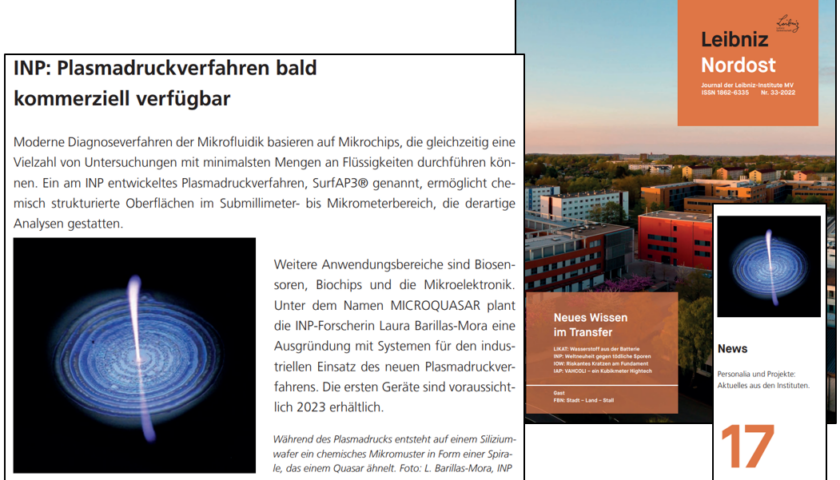Greifswald, Germany – September 30, 2023 – MicroQuasar Technologies, a spin-off from the Leibniz-Institut für Plasmaforschung und Technologie (INP) located in Greifswald, Germany, marked its initial appearance in the media with a mention in the Journal Leibniz Nordost, issue number 33-2022, published in September 2022.
The Journal Leibniz Nordost, published semi-annually by the Leibniz Institutes in Mecklenburg-Vorpommern, serves as a platform for reporting current research, offering insights into institute life, and introducing key research personalities.

The original German text reads as follows:
INP: Plasmadruckverfahren bald kommerziell verfügbar.
Moderne Diagnoseverfahren der Mikrofluidik basieren auf Mikrochips, die gleichzeitig eine Vielzahl von Untersuchungen mit minimalsten Mengen an Flüssigkeiten durchführen können. Ein am INP entwickeltes Plasmadruckverfahren, SurfAP3® genannt, ermöglicht chemisch strukturierte Oberflächen im Submillimeter- bis Mikrometerbereich, die derartige Analysen gestatten. Weitere Anwendungsbereiche sind Biosensoren, Biochips und die Mikroelektronik. Unter dem Namen MICROQUASAR plant die INP-Forscherin Laura Barillas-Mora eine Ausgründung mit Systemen für den industriellen Einsatz des neuen Plasmadruckverfahrens. Die ersten Geräte sind voraussichtlich 2023 erhältlich (FOTO. Während des Plasmadrucks entsteht auf einem Siliziumwafer ein chemisches Mikromuster in Form einer Spirale, das einem Quasar ähnelt. Foto: L. Barillas-Mora).
Leibniz Nordost No. 33-2022
In English, the text reads as:
INP: Plasma printing process soon to be commercially available
Modern microfluidics diagnostic methods are based on microchips that can simultaneously perform a wide range of examinations using minimal amounts of fluids. A plasma printing process developed at INP, called SurfAP3®, enables chemically structured surfaces in the submillimeter to micrometer range that allow such analyses. Other areas of application include biosensors, biochips and microelectronics. Under the name MICROQUASAR TECHNOLOGIES, INP researcher Laura Barillas-Mora is planning a spin-off company with systems for industrial use of the new plasma printing process. The first devices are expected to be available in 2023 (PHOTO. During plasma printing, a chemical micropattern in the form of a spiral resembling a quasar is formed on a silicon wafer. Photo by L. Barillas-Mora)
Source publication: https://www.inp-greifswald.de/fileadmin/user_upload/LeNO_Internet_Doppelseite_Nr33.pdf
MicroQuasar Technologies develops direct-writing plasma printing solutions to drive innovation in microfabrication for advanced manufacturing and prototyping, using atmospheric-pressure microplasma for high resolution surface modification.
For more information, visit www.microquasartech.de or contact us at info@microquasartech.de.
